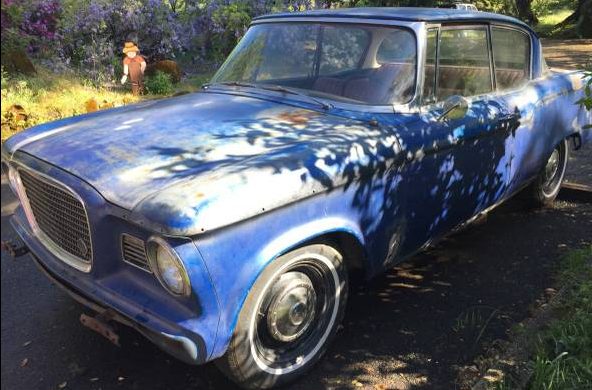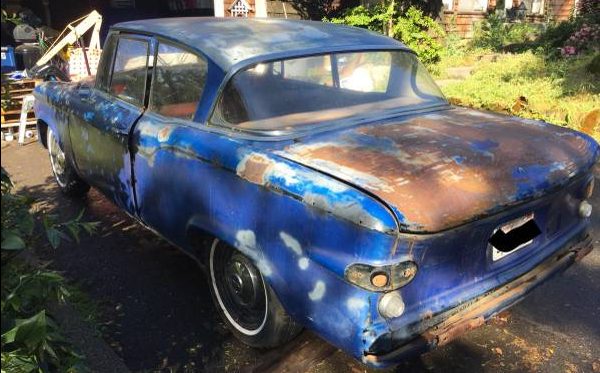When you think of a 1950s 2 door hardtop with a V8 and a manual transmission, this is not likely the car you’re thinking of, but here it is. If the design looks a bit awkward or perhaps squished, many would just say ugly, it’s a full sized Studebaker made into a compact by chopping off the ends and taking out a bit out of the wheelbase ahead of the firewall. This Lark is listed on craigslist in Loomis, California for a modest $2,300. It runs but needs an axle to drive. It looks like a solid original car with only surface rust.
The interior looks to be in surprisingly good condition. It’s had good care and possibly restoration at some point in time. The radio is said to work, but is that an aftermarket radio?
Things look mostly original under the hood. That bundle of stray wires may need attention. That’s a 180 horsepower 259 CID V8 with a 3 speed manual with overdrive. It isn’t a performance engine by any means, but it could still be fun.
That could be original paint. If you wanted a white top on your Lark this is what you got. The bumpers and trim are included with the sale, but there’s no word on the tail lights. The surface rust is described as light. The running gear should be the same on a lot of Studebakers so the axle shouldn’t be hard to find. The taillights may be more difficult. At $2300 it looks like it wouldn’t take too much to restore this to a driver if there’s not too much rust. It will be interesting to see what you think of this Lark.






Three-on-tree + a V8! My dad had an Impala with that combo – It was a blast to drive! Love it!
A friend of mine owned one of these with a V8 4 spd, and it was a rocket. In the day, it was a good buy.
Gotta see it finished to appreciate it…
That’s nice.
WOW!!!
As a former owner of a 62 Studebaker ‘Super Lark’ convertible (V8, four speed, Avanti engine, positraction) — a really sweet car I’ve always regretted selling —
I don’t understand this from your write up:
“design looks a bit awkward or perhaps squished, many would just say ugly, it’s a full sized Studebaker made into a compact by chopping off the ends and taking out a bit out of the wheelbase ahead of the firewall.”
The Lark was the full size Studebaker … the only other models were the Hawk and the Avanti. I don’t think the 2-door Lark had a shorter wheelbase than the 4 door. (There was an extended wheelbase model.)
The Lark was marketed as a “compact” car but it had the same generous interior room of their previous “full size” cars since it shared the same body. It was a brilliant way to get a new car model with minimal tooling. If they hadn’t hit the market with the Lark two years before the big three introduced their compacts, Studebaker may never have lasted long enough to bring out their awesome GT Hawks and Avantis.
I like it….all the makings for a nice driver or moderate resto-mod on a budget.
I think it looks stylish and in proportion.
A recent posting that looks a bit odd is the Imp…the roof looks like it came off an airport tug…from the windows down it looks good.
Exactly what they did, using the same basic body since 1953, chopping down the front and rear thus creating the Lark.
I like Larks.
I own a 60 Lark, same drivetrain. Always gets attention as they are pretty uncommon on the road these days.
Like it…the evil twin in black!
These are not coupes. Studebaker called them hardtop sedans.
I had a q960 like hardtop, 259 v8 3 on three with overdrive. It was a sweet driving car, I regret selling it.
I don’t know where the comment that the V8 with manual isn’t a performance powertrain comes from. It was a virtual hot rod in the small, light Lark body. A Lark V8 could reach 60 in 10 seconds flat, easily beating many full size cars of the day and crushing the 1960 compacts from the Big Three. The Rambler Rebel was bigger, and it was the 1961 model year before the Big Three started offering some V8s in compacts. The Lark offered full size room and good driving characteristics. Unfortunately it also could rust out before your eyes in tough climates, and it looked somewhat dated the moment it appeared, for obvious reasons. I think this car was originally black. It’s a sharp color in the hardtop with red interior and wide whites.
Yes, but this is a low-spec V8 from a maker who also put much more powerful engines in its Hawks.
What Paul said and some other’s….the Lark pretty much saved Studebaker when it came out. Had one of these in the hard top form with a six/three on the tree – one I sold way back. This was a compact – produced to compete with the others – but this was offered with a V/8 the others wouldn’t have until 63/64….
The 1953 Studebaker was a fairly narrow body when compared to the other American cars on the market, and it was this body shell that continued thru the early Larks and even the Hawks. It’s true that Studebaker chopped off overhang front & rear, plus they revised the roof line behind the windshield.
Almost every part for Studebaker Larks are available. A huge amount of spare parts was stocked by Studebaker up thru the late 1970s.
Last week I visited the Studebaker Museum in South Bend, Indiana, This is an important automotive museum that is a “must see” if you are in the Michiana area. It is more than just Studebakers, It even has the Studebaker brother’s collection of US Presidential carriages, including the one that transported President Lincoln to Ford’s Theater that fateful night.
Also there on display is the 1956 Packard Predictor, my “dream car”. I was fortunate to arrange in advance to actually sit in the predictor while there, a dream I’ve had for 61 years. [see attached photo]